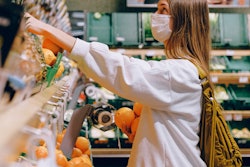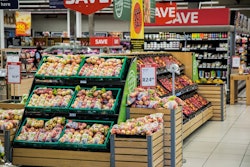
The Coronavirus disease (COVID-19) pandemic has disrupted food supply chains across the world. Despite assurances from retailers and food producers that the food supply is stable, they are scrambling to keep up as consumer demand rapidly escalates.
As the unprecedented worldwide response to the pandemic continues to expand in scope and measure, it has become even more difficult to legitimize products. Quarantines and travel restrictions give bad actors the opportunity to counterfeit food and hide its unsafe journey to store shelves.
Consumers worry about the source of their food as well as what countries and channels it has passed through. While this problem is not new (for example, the sickening of 300,000 babies in China due to melamine-laced milk and infant formula), the current global crisis has further highlighted the issue. Companies must take immediate action to protect both their customers and brands. Efficient, reliable processes and authentication tools are more important than ever, as food suppliers search for new ways to track and manage their supply chains.
Combat counterfeit
The most important aspect of navigating the new complexities of the food supply chain is mitigating risk stemming from counterfeit or substandard food, lapses in quality and safety, product recalls and liability and unauthorized diversion.
Human inspection is still the first line of defense. It addresses problems that machines may miss or are not calibrated to detect. However, under current circumstances, the workforce is overworked and distracted across the whole supply chain. As such, retailers and manufacturers must find new tools and strategies to augment the effectiveness of their stretched resources and infrastructure. Technology exists that can address this. Not only can these technologies assist through the present crisis, but once implemented, they enable far more diligent and effective management of food supply from farm to fork.
The food supply chain has always been vulnerable to authenticity and determination of provenance. It urgently needs safe, covert, flexible, and resilient tracking tools to guarantee authenticity, safety, and source. These tools will help manufacturers stay a step ahead of bad actors by using technologies not easily duplicated. There are a number of tracking, verification, and traceability solutions currently available. These range from invisible inks and complex serialization to low-cost, highly-secure, and edible barcodes that can be applied both on package and directly on-food. In fact, edible optical barcodes are currently being adopted as an on-pill solution in the pharmaceutical space, another industry plagued by counterfeiting and diversion.
In a post-COVID-19 world, the pressure on global supply chains to meet the demand stemming from an ever-growing world population, coupled with the rapidly worsening problem of counterfeit and substandard food, will require significant leveraging of technology to keep consumers safe and protect brands. The required technologies will need to be secure, not easily duplicated, affordable, and flexible enough to be applied directly to food products. This mitigates fraud if food is removed from its packaging. To involve the consumer in the process, these technologies will need to use mobile phone reader-based platforms. Not only will this vastly enhance the points of authentication, but it will enable unprecedented levels of engagement between producers, brands, and consumers. The sheer volume of authentication nodes, commensurate data sharing and communication will prove too daunting for illicit players in the global food supply chain. The current crisis presents producers and brands with a unique opportunity to leverage prevailing consumer awareness and sentiment to implement technologies that promote consumer safety, engender brand loyalty, and boost the legal bottom line in the future.
Control diversion
With current events throwing supply chains into turmoil, product diversion is an additional problem to counterfeiting. Borders are closing and food suppliers are forced to instantaneously change plans with little to no warning. This puts extra pressure on producers and brands to accurately manage their distribution and point of sale channels from an intended market, region and country perspective.
Global brands employ sophisticated market and geography-centric pricing models to optimize the economics of supply, demand, and economics. The illicit diversion of food from intended markets can result in a significant and adverse bottom-line impact for legitimate companies. Unfortunately, illicit diversion is not perpetrated only by illegitimate and criminal players. Legitimate participants in the food packaging and distribution infrastructure also add to the problem. The same solutions that can be applied in the enforcement of authentication and provenance can also be applied here, enabling manufacturers and brands to combat illegal diversion and ensure the proper operation of their legitimate channel partners.
As in the case of authentication, involving the consumer via mobile phone-based reader platforms will greatly enhance the effectiveness of monitoring and enforcement. This helps ensure that the right foods are sold in the right markets and geographies. Taken as a whole, effective management of counterfeit products and diversion transfers economic benefits from insidious elements to legitimate producers and brands. This simultaneously ensures consumer health, safety, and satisfaction.
Manage recall
Recalls have hit a record high in recent years. The discovery of safety issues or product defects creates substantial liability throughout the supply chain. The decision faced by companies on how broadly to initiate a product recall has huge financial ramifications, especially under the current global economic climate.
Obviously, quality and consumer confidence is the cornerstone of all supply chains. However, the sheer diversity and volume of food products produced daily around the globe lends itself to inspection failures or inadequate quality assurance. These lapses can happen at all points of food production, processing, packaging, and distribution. Leveraging emerging and secure “track and trace” technologies, implemented on-package or directly on-food, will allow for more rapid detection, containment, and response to quality lapses. This helps avoid brand damage caused by consumer dissatisfaction or crushing economic liability in cases involving human health and safety. The speed of detection, containment, and response is becoming more important in a connected world where consumer, legal, and regulatory response is near-instantaneous.
The global food supply chain is continually increasing in size and complexity. The same old solutions that were put in place decades ago are wholly insufficient in addressing the problem of counterfeit, diversion, and recall. The economic size of this problem is estimated to exceed $40 billion annually and results in the loss of wellness or life in millions of people. New technologies and solutions are urgently needed in the food industry. The first movers among producers, brands, and retailers will reap significant economic and customer loyalty benefits at the expense of companies too set in their ways to evolve.



















